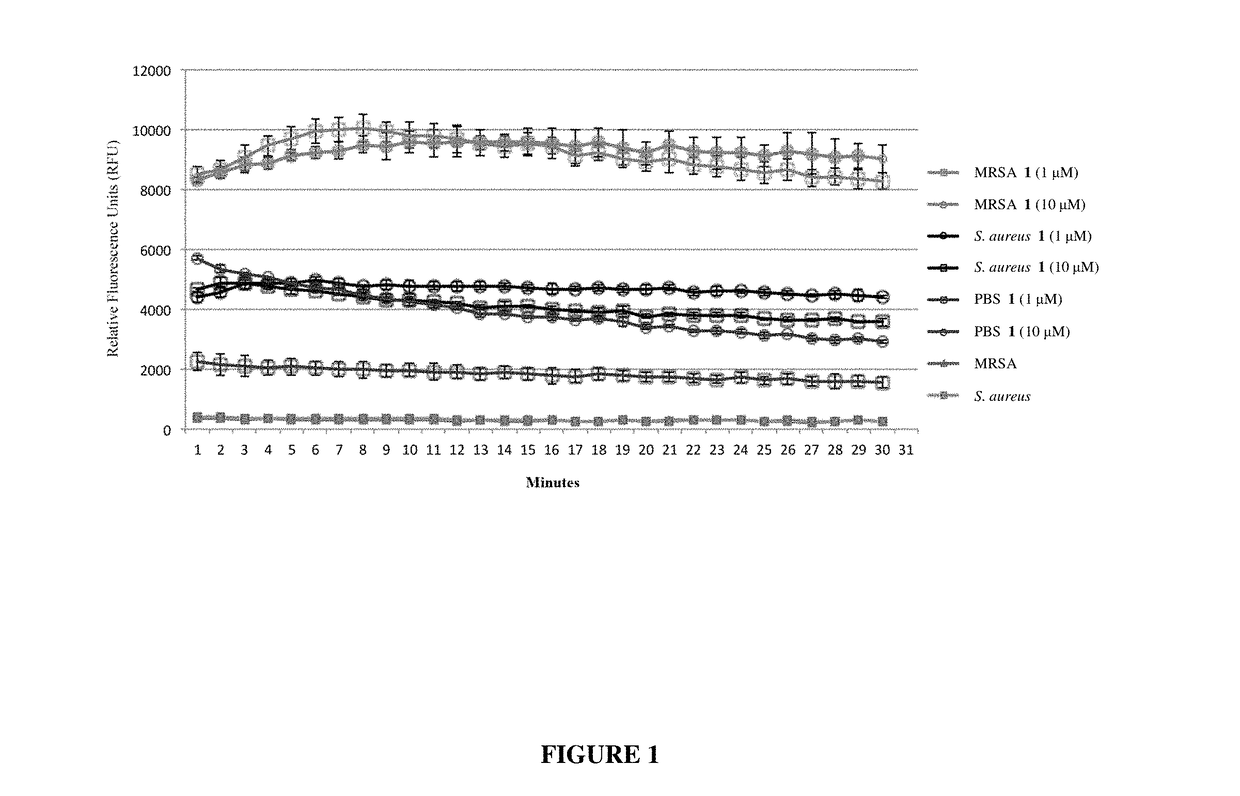Antibiotic sensitivity-restoring and photosensitive agents
a technology of antibiotics and photosensitive agents, applied in the field of antimicrobial therapy, can solve problems such as the emergence of drug-resistant bacteria, and achieve the effect of decreasing drug resistance in the cell
- Summary
- Abstract
- Description
- Claims
- Application Information
AI Technical Summary
Benefits of technology
Problems solved by technology
Method used
Image
Examples
example 1
of 2,3-di-((E)-2-arylethenyl)indoles
[0202]2,3-di-((E)-2-Arylethenyl)indoles (compounds 1-6) were prepared using oxidative Heck coupling as detailed in Scheme 1.
[0203]
[0204]Palladium acetate (0.1 eq) was added to a mixture of a selected styrene (4 eq), copper (II) acetate (4 eq), and indole (1 eq) in DMF / DMSO (9:1). The reaction mixture was stirred at 70-80° C. for 18-24 hours with thin-layer chromatography (TLC) monitoring of the reaction progress (20% EtOAc / hexanes). The reaction was cooled to room temperature and partitioned between minimal amounts of water and EtOAc, which was filtered through a plug of celite. The layers were then separated and the organic layer was washed with saturated brine solution, dried over MgSO4, filtered, and concentrated under reduced pressure. Flash chromatography afforded the desired 2,3-di-((E)-2-arylethenyl)indoles as depicted below:
[0205]
[0206]Yield 41%; 1H NMR (400 MHz, DMSO-d6) δ 11.60 (s, 1H), 8.09 (d, J=8.0 Hz, 1H), 7.80 (ddd, J=16.5, 7.8, 4.6...
example 2
of Compounds of the Invention on HeLa and WI38 Cells
[0229]The toxicities of the compounds of the invention were determined for human cancerous cervical epithelium HeLa and normal lung fibroblast WI38 cells. The toxicities of EPIs INF-55 and INF-55Cl were quantified as controls.
[0230]TABLE 1 shows the measured toxicities (IC50; μM) of the compounds of the invention and the EPIs INF-55 and INF-55Cl against HeLa cells. TABLE 2 compares the toxicity of compounds 7-11 on HeLa cells and normal WI38 cells. The results indicated that compounds 7, 9, and 10 killed cancerous HeLa cells at concentrations that were not toxic to normal WI38 cells in culture.
[0231]
TABLE 1CompoundIC50 HeLaCompoundIC50 HeLa 168.9 ± 4.820Non-Toxic 738.55 + / − 2.5221 8.2 ± 1.0 831.56 + / − 1.7422 3.2 ± 0.4 934.37 + / − 0.852312.9 ± 3.21036.82 + / − 1.532423.9 ± 1.81125.85 + / − 2.4725 13 ± 3.51316.4 ± 1.12618.6 ± 1.11412.2 ± 1.62712.5 ± 0.215Non-Toxic28 8.6 ± 1.416 6.4 ± 1.02911.6 ± 0.71814.3 ± 0.73034.4 ± 5.01935.8 ± 6 31N...
example 3
nhibitory Concentrations (MICs) of Compounds of the Invention and Antibiotics Against MRSA Isolates
[0233]The MICs of S. aureus ATCC 33591, BAA-44, BAA-1707, BAA-1717, BAA-1720, BAA-1747, BAA-1754, BAA-1761, BAA-1763, BAA-1764, and BAA-1766 were measured using a cell concentration of about 5×105 colony forming units (CFU) / mL. In a 96-well microtiter plate, two-fold dilutions were made of each drug (starting with 100 μM) in 100 μL of a cell suspension in trypticase soy broth (TSB). The samples were incubated overnight at 37° C. on a rotary shaking incubator set at 100 revolutions per minute (rpm) and were visually inspected for turbidity. A 20% well-volume of 3-(4,5-dimethylthiazol-2-yl)-2,5-diphenyltetrazolium bromide (MTT reagent, 5 mg / mL) was added, and the samples were incubated for about 20 minutes. The MICs were determined as the lowest concentration at which full visual inhibition was observed by the unaided eye.
[0234]TABLE 3 shows the MICs of compound 1 and compounds 7-9 again...
PUM
| Property | Measurement | Unit |
|---|---|---|
| wavelength | aaaaa | aaaaa |
| length of time | aaaaa | aaaaa |
| emission wavelength | aaaaa | aaaaa |
Abstract
Description
Claims
Application Information
 Login to View More
Login to View More - R&D
- Intellectual Property
- Life Sciences
- Materials
- Tech Scout
- Unparalleled Data Quality
- Higher Quality Content
- 60% Fewer Hallucinations
Browse by: Latest US Patents, China's latest patents, Technical Efficacy Thesaurus, Application Domain, Technology Topic, Popular Technical Reports.
© 2025 PatSnap. All rights reserved.Legal|Privacy policy|Modern Slavery Act Transparency Statement|Sitemap|About US| Contact US: help@patsnap.com



